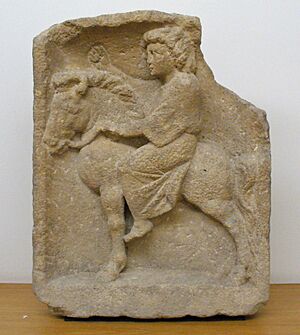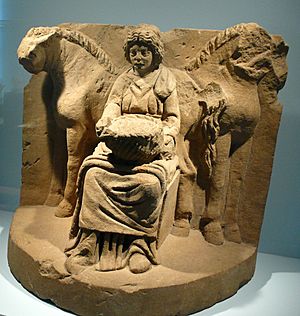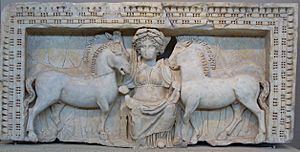Epona facts for kids
In the ancient Gallo-Roman religion, Epona was a special goddess. She was known as the protector of horses, ponies, donkeys, and mules. People also saw her as a goddess of fertility, which means she was connected to new life and growth. This was shown by things like a `patera` (a shallow bowl), a `cornucopia` (a horn of plenty), and ears of grain. Sometimes, sculptures of Epona even included foals (baby horses). Some believed that Epona and her horses could guide souls in the afterlife. Her worship was very popular across the Roman Empire between the first and third centuries AD, especially among cavalry (soldiers on horseback). This was quite unusual for a Celtic goddess, as most were linked to specific places.
Contents
What Her Name Means
Even though we know about Epona from Roman times, her name comes from the ancient Gaulish language. It means 'Great Mare' or 'Great Horse'. The name comes from an even older word, `*ekʷos`, which meant 'horse'. This old word is also where the modern Welsh word `ebol` (meaning 'foal') comes from.
Where We Find Evidence of Epona
The earliest signs of Epona's worship were found in areas along the Danube River. Some experts thought she was brought to Gaul (ancient France) by horsemen from the east. However, this idea is not widely accepted today.
Even though her name is Gaulish, most messages and carvings dedicated to Epona are in Latin. Sometimes they are in Greek. These messages were made not only by Celts but also by Germans, Romans, and other people living in the Roman Empire. For example, a message found in Mainz, Germany, shows that a Syrian person dedicated it to Epona.
One long Latin message from the first century BC was found in France. It was carved into a lead sheet and was part of a ritual where a young horse was sacrificed. This message called Epona by many different names, like `Eponina` (dear little Epona) and `Potia` (powerful Mistress).
Epona's special day in the Roman calendar was December 18th. This was noted on a calendar found in Italy, but it might have been a local celebration. She even became part of the `imperial cult`, which meant people prayed to her for the Emperor's well-being. They would call her `Epona Augusta` or `Epona Regina`.
As Gaul became more Roman, Epona's role changed. She became known as a protector of cavalry soldiers. Her worship spread across the Roman Empire because of the auxiliary cavalry. These were special units of horse soldiers, especially the Imperial Horse Guard. Many of their dedications to Epona were found in Rome. Her worship was also common in parts of modern-day Austria.
There is an old story about Epona's origin, which says that a man named Fulvius Stellus disliked women. He spent time with a mare, and the mare gave birth to a beautiful girl named Epona. She then became the goddess who protects horses. This story might be a very old memory of horse rituals from ancient times.
How Epona Was Shown in Art
Sculptures of Epona show her in different ways:
- Riding: She is often shown sitting sideways on a horse, or sometimes lying on one. This was common in Gaul.
- Seated or Standing: She might be sitting or standing in front of a horse, or between two horses.
- Horse Tamer: Sometimes she looks like a horse tamer.
- Symbolic: She can also be shown as a mare with a foal.
In the `Imperial type` of art, which was more common outside Gaul, Epona sits on a throne. She is usually surrounded by two or more horses or foals. In a distant place called Dacia, she was shown on a stone slab. She was seated on a throne with her hands on the necks of two horses, similar to how the goddess Cybele was shown with lions.
Epona in Stories and Art
Epona is mentioned in a famous Roman book called `The Golden Ass` by Apuleius. In the story, a small shrine with her image in a stable is decorated with fresh roses.
The Roman poet Juvenal also wrote about Epona. He connected her worship and images to stables. Small statues of Epona have been found in Roman stables and barns across many areas.
Epona is indirectly mentioned in Victor Hugo's book `Les Misérables` through the character named Éponine.
In the popular video game series `The Legend of Zelda`, the main character Link's horse is named Epona. This horse is always shown as a brown or chestnut mare with a white mane.
The musician Enya has a song titled `Epona` on her 1987 album, which was part of a TV documentary called `The Celts`.
Epona in Britain
The giant chalk horse carved into a hillside in Uffington, England, is very old. It might be too old to be directly linked to Epona.
Some old traditions in the West Country of England, like the `hobby-horse` parades on May Day, were thought by some experts to be linked to Epona. These parades involved people dancing with horse costumes. However, there is no strong proof that these festivals existed before the 18th century.
A small Roman bronze statue of Epona was found in England. She is seated, with a tiny mare and stallion next to her. She holds large ears of grain in her lap and right hand. The ponies also have grain coming from their mouths. On her left arm, she holds a yoke, which is a unique detail for this statue.
In medieval Welsh stories called the `Mabinogion`, a queen named Rhiannon rides a white horse. Her horse moves slowly but can outrun anything. Rhiannon is wrongly accused of a crime and has to act like a horse as punishment. She offers to carry travelers and tells them her story. Some people have tried to connect Rhiannon to Epona, but Rhiannon is a much later character from literature.
A Welsh folk ritual called `Mari Lwyd` (Grey Mare) still happens in December. Some experts believe it might be a survival of Epona's worship. But again, there is no strong proof about its age or original purpose.
Epona Today
On Mackinac Island in Michigan, USA, Epona is celebrated every June. This includes stable tours, a blessing of animals, and a parade. Mackinac Island does not allow cars, so horses are very important there. The "Feast of Epona" involves a local church leader blessing horses and other animals.
Today, Epona is also worshipped by `neo-druids` and other modern pagans who follow ancient beliefs.
|




